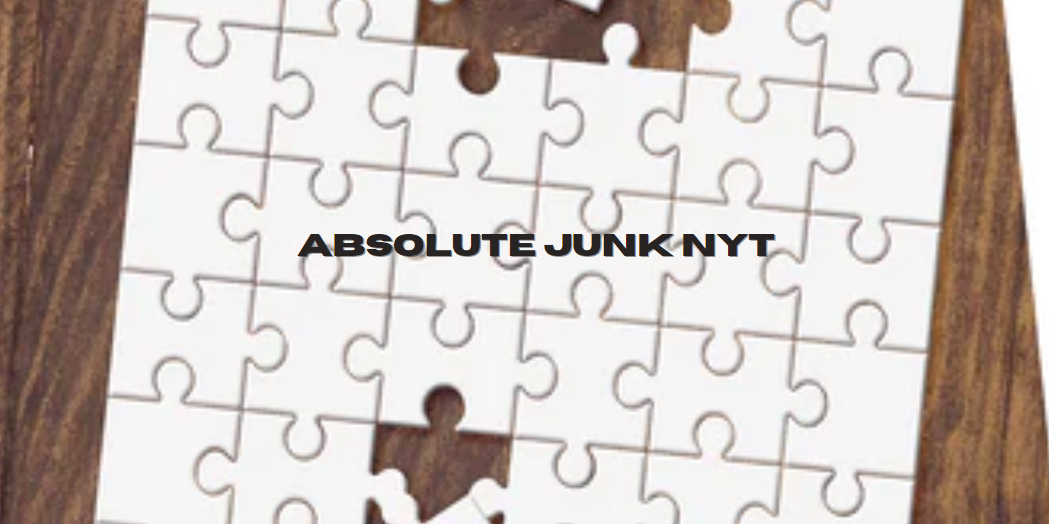Contents
- 1 Introduction
- 2 The Origin of “Absolute Junk NYT”
- 3 The Role of Crossword Puzzles in Modern Culture
- 4 Analyzing “Absolute Junk NYT”: Why the Phrase Resonates
- 5 The Emotional Journey of Solving a Crossword Puzzle
- 6 The Broader Implications of “Absolute Junk NYT”
- 7 FAQs about “Absolute Junk NYT”
- 7.1 What does the phrase “absolute junk NYT” mean?
- 7.2 Why has the phrase “absolute junk NYT” become popular?
- 7.3 How does the New York Times crossword puzzle impact modern culture?
- 7.4 What role do crossword puzzles play in mental and emotional well-being?
- 7.5 How has digitalization affected crossword puzzles?
- 8 Conclusion
Introduction
The phrase “absolute junk NYT” has become a notable point of discussion, particularly in the context of the New York Times (NYT) crossword puzzle. This phrase, often seen in crossword clues, reflects a blend of modern lexicon and the traditional puzzle culture that the NYT crossword embodies.
The phrase encapsulates a moment where everything aligns, offering a sense of pure bliss and contentment to those who solve it, yet also frustration for those who find themselves stuck. This article delves deeply into the meaning, cultural significance, and broader implications of the phrase “absolute junk NYT,” providing unique interpretations, analyses, and insights that go beyond what’s already available online.
Our exploration will also touch on the evolution of crossword puzzles, the role of the New York Times in popularizing this pastime, and the reasons why the phrase “absolute junk NYT” has resonated with so many people. For enthusiasts and casual solvers alike, this comprehensive guide aims to offer a richer understanding of this intriguing phrase.
The Origin of “Absolute Junk NYT”
The New York Times Crossword Puzzle: A Brief History
The New York Times crossword puzzle has long been considered the gold standard of word puzzles. First published in 1942, it quickly gained a reputation for its clever clues, challenging grids, and cultural references. The NYT crossword is not just a puzzle; it’s a cultural artifact that reflects and influences the society in which it exists.
Over the decades, the NYT crossword has evolved, incorporating modern language, pop culture, and contemporary references. This evolution has kept the puzzle relevant and engaging for new generations of solvers, while also challenging seasoned enthusiasts with its ever-increasing complexity.
The Phrase “Absolute Junk NYT”: Its Introduction into the Puzzle
The phrase “absolute junk NYT” appears to have entered the lexicon of crossword enthusiasts as a reaction to certain clues or answers that are perceived as frustrating, obscure, or nonsensical. It encapsulates the moments when a solver feels exasperated by an answer that doesn’t seem to fit logically, yet is correct within the context of the puzzle.
This phrase may also reflect a broader sentiment towards certain modern clues that deviate from traditional crossword norms, often polarizing the solving community. While some may see these clues as innovative and refreshing, others view them as unnecessary complications that detract from the puzzle’s enjoyment.
The Cultural Significance of the Phrase
The phrase “absolute junk NYT” has grown beyond its initial context to become a symbol of the love-hate relationship many have with the NYT crossword. It captures the duality of the experience—where the satisfaction of solving a challenging puzzle coexists with moments of frustration when encountering seemingly illogical or overly difficult clues.
In this way, “absolute junk NYT” serves as a shorthand for the emotional rollercoaster that is the NYT crossword experience, encapsulating the joy, the agony, and ultimately, the contentment that comes with completing a puzzle.
The Role of Crossword Puzzles in Modern Culture
Crossword Puzzles as a Form of Entertainment
Crossword puzzles have long been a popular form of entertainment, offering a mental challenge that engages solvers in a way few other pastimes do. For many, solving a crossword is more than just filling in the blanks; it’s an exercise in pattern recognition, language comprehension, and lateral thinking.
The NYT crossword, in particular, has become a daily ritual for countless individuals. Its clues often reference current events, pop culture, and literature, making it a reflection of contemporary society. The challenge of completing the NYT crossword offers solvers a sense of accomplishment and a moment of bliss when everything falls into place.
The Impact of Digitalization on Crossword Puzzles
The digital age has transformed how people engage with crossword puzzles. While print versions remain popular, the rise of online platforms has made crossword puzzles more accessible than ever. Digital versions of the NYT crossword allow solvers to tackle the puzzle on their own time, with features like auto-checking answers and hints making the experience more customizable.
The digital era has also given rise to crossword communities, where enthusiasts can discuss clues, share tips, and express their frustrations—often coining phrases like “absolute junk NYT” in the process. These communities have helped to maintain the relevance of crosswords in a fast-paced, tech-driven world.
The Role of the New York Times in Shaping Crossword Culture
The New York Times has played a pivotal role in shaping crossword culture. As the most widely recognized and respected crossword puzzle, the NYT crossword sets the standard for puzzle-making and solving. It has inspired countless other crosswords and has even influenced language and culture, as seen with phrases like “absolute junk NYT.”
The NYT crossword’s editorial team is known for pushing boundaries, incorporating new words, slang, and cultural references that challenge traditional notions of what a crossword should be. This approach has kept the puzzle fresh and engaging, while also sparking debate among solvers about the direction in which the puzzle is heading.
Analyzing “Absolute Junk NYT”: Why the Phrase Resonates
Frustration as a Key Element of the Puzzle Experience
The phrase “absolute junk NYT” resonates with solvers because it captures the frustration that is an inherent part of the puzzle-solving experience. Crosswords are designed to be challenging, and not every clue or answer will be immediately apparent. The satisfaction of solving a difficult puzzle is often tempered by moments of irritation when a clue seems obtuse or an answer feels unsatisfactory.
This frustration is a natural part of the process, and for many, it’s what makes the eventual solution all the more rewarding. The phrase “absolute junk NYT” is a way for solvers to express this frustration, often with a hint of humor, acknowledging the emotional highs and lows that come with tackling a tough puzzle.
The Evolution of Crossword Language and Its Impact on Solvers
The language of crosswords has evolved over time, reflecting changes in society, culture, and technology. Modern crosswords, including the NYT puzzle, often incorporate slang, internet culture, and contemporary references that can be challenging for solvers who are more accustomed to traditional puzzle language.
This evolution can lead to moments where a clue or answer feels out of place or nonsensical, prompting reactions like “absolute junk NYT.” These moments highlight the tension between the old and new in crossword culture, as solvers navigate a changing landscape of language and references.
The Role of Community in Shaping Crossword Discourse
Crossword communities play a significant role in shaping the discourse around puzzles, including the use of phrases like “absolute junk NYT.” These communities, whether online or in person, provide a space for solvers to share their experiences, frustrations, and triumphs. They also contribute to the development of a shared language and culture around crosswords.
In these communities, phrases like “absolute junk NYT” become part of the collective experience, a shorthand for the ups and downs of solving a puzzle. This sense of shared experience helps to reinforce the bond among solvers and adds to the richness of crossword culture.
The Emotional Journey of Solving a Crossword Puzzle
The Thrill of the Challenge
For many solvers, the thrill of the challenge is what draws them to crossword puzzles. The NYT crossword, in particular, is known for its difficulty and the sense of accomplishment that comes with completing it. Each puzzle presents a new set of challenges, from tricky wordplay to obscure references, that require solvers to think creatively and persistently.
This challenge is part of what makes the crossword experience so rewarding. The moments of frustration, encapsulated by phrases like “absolute junk NYT,” are balanced by the joy of finally cracking a tough clue or filling in the last square. It’s a journey that involves both mental effort and emotional resilience.
The Satisfaction of Completion
There’s a unique satisfaction that comes with completing a crossword puzzle, especially one as challenging as the NYT crossword. This satisfaction is heightened by the journey it takes to get there—the moments of doubt, the breakthroughs, and the eventual realization that every piece fits together.
This moment of completion, where everything aligns and an overwhelming sense of contentment washes over the solver, is what keeps people coming back to crosswords. It’s a moment of pure bliss, a reward for the mental labor that went into solving the puzzle. The phrase “absolute junk NYT” captures the journey to this moment, acknowledging the frustrations along the way while celebrating the ultimate reward.
The Role of Puzzles in Mental and Emotional Well-being
Crossword puzzles are more than just a pastime; they offer significant benefits for mental and emotional well-being. The process of solving a crossword engages the brain in ways that can improve cognitive function, memory, and problem-solving skills. It also provides a form of mental exercise that can help to reduce stress and improve mood.
For many, solving a crossword puzzle is a form of meditation, a way to focus the mind and achieve a sense of calm. The challenges and frustrations encountered along the way, symbolized by phrases like “absolute junk NYT,” are part of this process, ultimately contributing to the sense of satisfaction and contentment that comes with solving the puzzle.
The Broader Implications of “Absolute Junk NYT”
The Phrase as a Reflection of Changing Media Consumption
The phrase “absolute junk NYT” also reflects broader trends in media consumption. As crossword puzzles and other forms of traditional media adapt to the digital age, they face new challenges in meeting the expectations of a changing audience. The integration of modern language and references into crosswords is one way in which the NYT has responded to these changes, though it has not been without controversy.
The phrase captures the tension between old and new, as solvers navigate the evolving landscape of crossword puzzles. It’s a reminder that media, including puzzles, must continually adapt to stay relevant, even as they strive to maintain the qualities that made them popular in the first place.
The Impact of Language and Culture on Puzzles
Language and culture have a profound impact on crossword puzzles, influencing both the clues and the answers. As society changes, so too does the language used in crosswords, reflecting new words, phrases, and cultural references. This evolution can be challenging for solvers, particularly those who are more accustomed to traditional puzzle language.
The phrase “absolute junk NYT” highlights the way in which these changes can be polarizing, with some solvers embracing the new while others resist it. It’s a reflection of the broader cultural shifts that are taking place, as language and media continue to evolve in response to changing societal norms.
The Future of Crossword Puzzles
As crossword puzzles continue to evolve, they will likely face new challenges and opportunities. The rise of digital media, the changing landscape of language and culture, and the increasing demand for innovative and engaging content will all shape the future of crosswords.
The phrase “absolute junk NYT” may continue to be a part of this evolution, capturing the frustrations and joys of solving puzzles in a changing world. As solvers navigate this evolving landscape, they will continue to find moments of pure bliss, where everything aligns, and an overwhelming sense of contentment washes over them.
FAQs about “Absolute Junk NYT”
What does the phrase “absolute junk NYT” mean?
The phrase “absolute junk NYT” is commonly used by crossword enthusiasts to express frustration with certain clues or answers in the New York Times crossword puzzle that they perceive as illogical, obscure, or unsatisfactory. It captures the emotional ups and downs of solving challenging puzzles.
Why has the phrase “absolute junk NYT” become popular?
The phrase has become popular among crossword solvers because it encapsulates the mixed emotions that come with solving difficult puzzles. It reflects both the frustration of encountering tough clues and the satisfaction of ultimately solving them.
How does the New York Times crossword puzzle impact modern culture?
The New York Times crossword puzzle is a cultural institution that reflects and influences modern culture. Its clues often reference current events, pop culture, and contemporary language, making it a mirror of society. The puzzle has also played a significant role in shaping the crossword community and crossword culture.
What role do crossword puzzles play in mental and emotional well-being?
Crossword puzzles offer significant benefits for mental and emotional well-being. They engage the brain, improve cognitive function, and provide a form of mental exercise that can reduce stress and improve mood. The process of solving a crossword can be meditative and rewarding, offering a sense of satisfaction and contentment.
How has digitalization affected crossword puzzles?
Digitalization has made crossword puzzles more accessible and customizable, allowing solvers to tackle puzzles on their own time and with features like hints and auto-checking. It has also given rise to online crossword communities, where enthusiasts can share tips and discuss puzzles, contributing to the evolving landscape of crossword culture.
Conclusion
The phrase “absolute junk NYT” is more than just a reaction to a challenging crossword clue; it’s a reflection of the complex emotions that come with solving one of the world’s most iconic puzzles. It captures the frustration, the joy, and the ultimate satisfaction of completing a crossword, serving as a symbol of the love-hate relationship many have with the NYT crossword.
As crossword puzzles continue to evolve, both in language and format, phrases like “absolute junk NYT” will likely remain a part of the solver’s experience. They are a testament to the enduring appeal of crosswords and the deep emotional connection they foster in those who tackle them.
In a world where language and culture are constantly changing, crossword puzzles offer a unique blend of tradition and innovation, challenging solvers to think creatively and persistently. The journey to that moment of pure bliss, where everything aligns and contentment washes over, is one that keeps solvers coming back, puzzle after puzzle, day after day.







